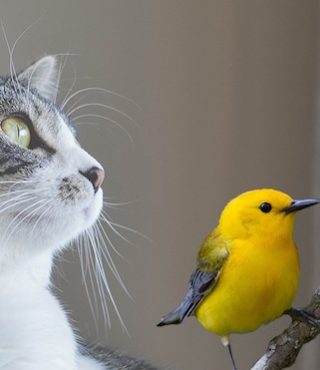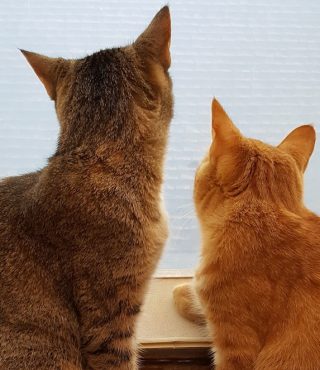A Trail Cam Backyard Cat-Bird Initiative

Sherril Guthrie conducted her own cats and birds initiative while living in Abbotsford, BC. Sarah Cooper, Project Manager for Cats and Birds, interviewed Sherril to learn more about her approach.
Sarah: Would you give us a sketch of what motivated you to undertake this project?
Sherril: Our new home was in a development that had removed huge swaths of habitat for birds and wildlife. So our landscape design focused on restoring as much as we could on a residential lot. Within two years our backyard was a bird nursery with nesting sites for various species, and plenty of natural food like bugs, grubs, seeds, berries, and nectar—so no need for hanging feeders. Sadly, we soon started to find feathery evidence of hunting activity. We knew we had birds of prey visiting our yard, and coyotes and bobcats, and some neighbours had cats. To get answers, we purchased two Moultrie outdoor, motion-activated cameras and positioned them in the backyard. The trail cam initiative became a “who done it?” My husband took on the task of reviewing the footage every few days, and that’s how we learned what was really going on in our backyard. This is a short video edited from the footage, with images of actual predation edited out because it’s simply too upsetting to watch.
Sarah: So what exactly did you learn?
Sherril: Well, the video confirmed that our backyard was a busy place, day and night. In all we identified more than 30 different bird species —many of them ground nesters and feeders. Coyotes, bobcats, cougars, and other wildlife also came and went. And we found that we had16 different cats in our yard on a regular basis. All the cats were owned—not feral—and one belonged to neighbours who had told us that he was “strictly indoor.” So in the weeks that followed we figured out who owned some of the cats and went to talk to them, pictures in hand. I told them we’d appreciate it if they’d please keep their cat indoors, or at least in their own yard. I explained why, offered information on Abbotsford’s Good Neighbour bylaw (which doesn’t allow nuisance activities by pets on another neighbour’s property). I also explained the risks of injury, death and disease for their cat, and, of course, the impact on birds.
Sarah: What kind of reactions did you get?
Sherril: A bit of everything, from neighbourly concern to embarrassment to defensiveness. One woman said their cat was young and she had to put it outside because it was too destructive in the house. When I explained how often it was in our yard and how it was jumping to get birds and breaking branches she said, “I’m going to get rid of that damn cat!” I told her that wasn’t necessary, and suggested she play with it more often and do some training instead. Another neighbour believed their cat just hung around their own yard when they “pushed it outside” and they were very surprised it travelled so far. It was reassuring when a young father apologized and thanked me for helping his kids understand the risks for outdoor cats. Days later we saw one of his girls taking their cat for a ride in her bicycle basket, but we never saw their cat in our yard again.
Sarah: So the cat problem was solved?
Sherril: Not exactly. The cameras remained in place, we continued to monitor the footage and although some neighbours complied with our request, there were cats we couldn’t connect to an owner, and cat owners who didn’t change their behaviour until stage two.
Sarah: Stage two?
Sherril: Stage two began with the purchase of a humane live animal trap, which is how you’re supposed to deal with problem cats in our municipality. We set it up and in less than an hour, I heard it snap shut. It was Buckley, our neighbour’s “strictly indoor cat”—now inside the trap.
Sarah: What did you do?
Sherril: We attempted to return Buckley to our neighbours and asked if they were having problems keeping him indoors. The husband got angry and said, “I don’t care, keep the damn cat!”
Sarah: So what happened to Buckley?
Sherril: Buckley was fine – safe and well fed overnight – and the next day we took him to the local BC SPCA. We explained the situation and they noted that Buckley had not been neutered. We made a donation for two days of care and gave them the owners’ address.
Sarah: Did they reclaim Buckley?
Sherril: Yes, they came that day, promptly installed a screen door that closed firmly to prevent further escapes, and we never saw Buckley in our yard again.
Sarah: Was that the end of stage two?
Sherril: Over the next few months we humanely trapped and temporarily cared for 7 more cats, performed 7 more drop-offs at the SPCA, and made 7 more donations to cover their care. The SPCA did a great job of educating the owners about responsible cat ownership, the importance of spay/neuter, and how to keep indoor cats happy and healthy.
Sarah: Would you recommend this approach to other people?
Sherril: Yes, absolutely, if their community has a nuisance bylaw, which many do, and it’s legal to use humane traps. You have to be willing to take the time to check the traps often, and take proper care of the cats you trap It can be challenging at first because it means stepping out of our comfort zone, having these conversations. But when you realize you’re helping both cats and birds and saving lives that matter, it’s worth it.








